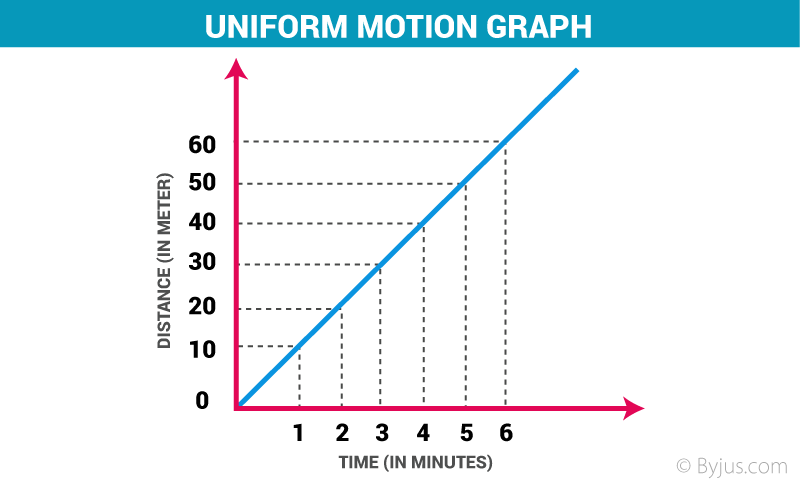
Uniform Motion:
Definition: This type of motion is defined as the motion of an object in which the object travels in a straight line and its velocity remains constant along that line as it covers equal distances in equal intervals of time, irrespective of the duration of the time.

If a body is involved in rectilinear motion and the motion is consistent, then the acceleration of the body must be zero.
Example of Uniform Motion:
- If the speed of a car is 10 m/s, it means that the car covers 10 meters in one second. The speed is constant in every second.
- Movement of blades of a ceiling fan.
Non Uniform Motion:
Definition: This type of motion is defined as the motion of an object in which the object travels with varied speed and it does not cover same distance in equal time intervals, irrespective of the time interval duration.

If a body is involved in rectilinear motion, and if the motion is not consistent, then the acceleration of the body must be non-zero.
Example of Non Uniform Motion:
- If a car covers 10 meters in first two seconds, and 15 meters in next two seconds.
- The motion of a train.
Now, people usually get confused between uniform motion and uniform acceleration. In the later phenomena, the object is having a constant acceleration in rectilinear motion, which means the object has different speed in every second, which clearly defines that motion is changing.
Following is the table explaining concepts related to motion
Comparison table Between these two types of motions:
|
Comparison Parameters |
Uniform Motion |
Non Uniform Motion |
|---|---|---|
|
Average Speed |
The motion is similar to the actual speed of the object. |
The motion is different from the actual speed of the object. |
|
Rectilinear Motion |
It has zero acceleration. |
It has non-zero acceleration. |
|
Graph |
Distance-time graph shows a straight line |
Distance-time graph shows a curved line |
|
Distance |
Covers equal distances in equal time interval. |
Covers unequal distances in equal time interval. |
Uniform Circular Motion:
This type of motion is seen if an object is travelling at a constant speed around a fixed axis or center point, and the object travels around a curved path and it maintains a constant radial distance from the center point at any given time and it moves in a tangent to the curved path.
Non Uniform Circular Motion:
This type of motion is inconsistent because if an object is travelling at a variable angular speed around a fixed axis or center point, then the motion of that object is said to be inconsistent because the object covers a curved path and it will have some variable radial acceleration due to which its velocity would change every second.
Recommended Video





Thanks
Thankyou very much byjus
It is very useful
Best
can you please help me to show acceleration of a body is zero if it moves in uniform motion. Numerically with its formula
Yes, you are right. The acceleration of a body in uniform motion is zero.
As an example, let us consider a body moving in uniform motion with a velocity of 5 m/s from point A to B. The total time taken to complete this distance is 3 seconds. What is the acceleration of the body?
The acceleration of the body is calculated using the following formula:
a = (v-u)/t
here, v is the final velocity and u is the initial velocity
Substituting the values in the equation, we get
a = (5-5)/3 = 0
As the body is in uniform motion, there is no change in velocity as a result the initial and final velocity is the same.
Thanks
Is it necessary for the angle formed by the line on the x-axis and on the y-axis of uniform motion in a distance-time graph to be 45degree?
Thank you for ur great information!!
Thankyou so much. It helped me a lot in my project report
What is speed ?
Speed is defined as the distance divided by time.
Thank you very much
Does a body always have to travel in a straight line for uniform motion?
Yes, in a uniform motion the body travels in a straight line. Uniform motion is a type of motion in which a body has a constant speed and unvarying direction. This implies that the direction is fixed, in other words a “straight line.”